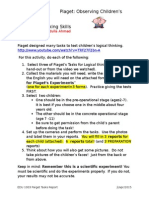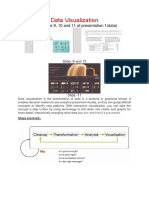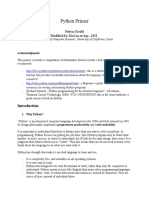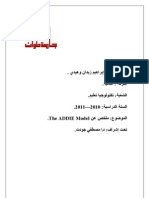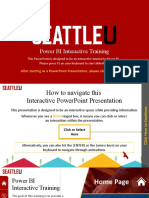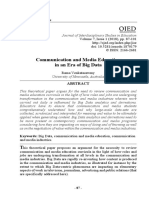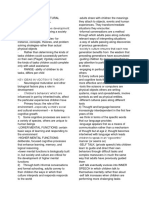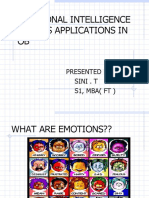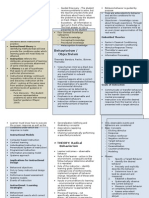0 ratings0% found this document useful (0 votes)
178 viewsData Visualization
This document discusses data visualization and provides guidance on creating effective visualizations. It defines visualization as conveying information through visual representations to enable viewers to gain insight into data. The goals of visualization are outlined as answering questions, making decisions, seeing context, finding patterns, and communicating insights. Key aspects of creating visualizations like using the right chart type, removing unnecessary elements, and focusing on truth, functionality, beauty and insight are covered.
Uploaded by
SreePrakashCopyright
© © All Rights Reserved
Available Formats
Download as PDF, TXT or read online on Scribd
0 ratings0% found this document useful (0 votes)
178 viewsData Visualization
This document discusses data visualization and provides guidance on creating effective visualizations. It defines visualization as conveying information through visual representations to enable viewers to gain insight into data. The goals of visualization are outlined as answering questions, making decisions, seeing context, finding patterns, and communicating insights. Key aspects of creating visualizations like using the right chart type, removing unnecessary elements, and focusing on truth, functionality, beauty and insight are covered.
Uploaded by
SreePrakashCopyright
© © All Rights Reserved
Available Formats
Download as PDF, TXT or read online on Scribd
You are on page 1/ 31
Data Visualization
Module 5
ADAX Data Star Program
Data Visualization
“…to convey information through visual
representations”
“…produces (interactive) visual
representations of abstract data to
reinforce human cognition; thus
enabling the viewer to gain knowledge
about the internal structure of the data
and casual relationships in it.”
Visualization Goals
• Answer questions (or discover
them)
• Make decisions
• See data in context
• Support graphical calculation
• Find patterns
• Present argument or tell a story
• Inspire
How Najib Razak
spend his day on
3 Functions of
Visualization
• RECORD: Store information
• ANALYZE: Support reasoning
about information
• COMMUNICATE: Convey
information to others
Visualization Wheel
Visualization Wheel
• Abstraction – Figuration: Boxes and charts (abstraction) or
real-world physical objects (figuration)
• Functionality – Decoration: No embellishments
(functionality) or artistic embellishments (decoration)
• Density – Lightness: Must be studied in depth (density) or
understandable at a glance (lightless)
• Multidimensional – Unidimensional: Different aspects of
phenomenon (multidimensional) or single or few items of
phenomenal (unidimensional)
Visualization Wheel
• Originality – Familiarity: Novel methods of visualization
(originality) or established and well understood methods
of visualization (familiarity)
• Novelty – Redundancy: Explaining each item once
(novelty) or encoding multiple explanations of the same
phenomenon (redundancy)
Qualities of a Great
Visualization
• Truthful
• Avoid deception, misleading your
audience
• Functionality
• Beauty
• Insightful
• Enlightening
• A combination of the previous
four, but with a social ethical
responsibility
Practical Considerations
• Beware of pie charts!
• Stay away from pie charts. A bar chart is almost always the
right choice
Practical Considerations
• A line chart is better at showing trends
Practical Considerations
• Lines won’t do that well if you are trying to show a
part/whole relationship
Remove to improve
Remove backgrounds
Remove redundant labels
Remove borders
Reduce colors
Remove special effects
Lighten labels
Direct label
Direct label
Before vs. After
Bad Visualization
Bad Visualization
Good Visualization
Good Visualization
You might also like
- The Power of Data Storytelling by Sejal Vora 2019 9789353282905 9789353282912 CompressNo ratings yetThe Power of Data Storytelling by Sejal Vora 2019 9789353282905 9789353282912 Compress249 pages
- Subject Code:Mb20Ba01 Subject Name: Data Visulization For Managers Faculty Name: Dr.M.KarthikeyanNo ratings yetSubject Code:Mb20Ba01 Subject Name: Data Visulization For Managers Faculty Name: Dr.M.Karthikeyan34 pages
- Data Visualization: For Analytics and Business IntelligenceNo ratings yetData Visualization: For Analytics and Business Intelligence49 pages
- Data Analysis and Visualization of COVID-19 Epidemic Based On PythonNo ratings yetData Analysis and Visualization of COVID-19 Epidemic Based On Python6 pages
- Training and Development: Managing Human ResourcesNo ratings yetTraining and Development: Managing Human Resources60 pages
- Data Visualization (Reference To First Slide Data Content)No ratings yetData Visualization (Reference To First Slide Data Content)5 pages
- Abell Model-Business Modeling - (Chapter 2 MSO)No ratings yetAbell Model-Business Modeling - (Chapter 2 MSO)35 pages
- Python Primer: Patrice Koehl Modified by Xin Liu in Apr., 2011No ratings yetPython Primer: Patrice Koehl Modified by Xin Liu in Apr., 201133 pages
- Paper - Commercial Vs Open Source Business Intelligence ToolNo ratings yetPaper - Commercial Vs Open Source Business Intelligence Tool6 pages
- Power Bi Interactive Training: After Starting As A Powerpoint Presentation, Please Click Here To BeginNo ratings yetPower Bi Interactive Training: After Starting As A Powerpoint Presentation, Please Click Here To Begin41 pages
- Visualisation For Data Science Predict Overview 3267No ratings yetVisualisation For Data Science Predict Overview 326715 pages
- Deep Learning and CNNFYTGS5101-GuoyangxieNo ratings yetDeep Learning and CNNFYTGS5101-Guoyangxie42 pages
- Written Report - Chapter 3 - Visualizing DataNo ratings yetWritten Report - Chapter 3 - Visualizing Data5 pages
- What Is A DSS?: Decision Support Systems Concepts, Methodologies, and Technologies: An OverviewNo ratings yetWhat Is A DSS?: Decision Support Systems Concepts, Methodologies, and Technologies: An Overview9 pages
- Ebook: Data Visualization Tools For Users (English)No ratings yetEbook: Data Visualization Tools For Users (English)26 pages
- The Elements of Data Analytic Style - Jeff Leek v01No ratings yetThe Elements of Data Analytic Style - Jeff Leek v0198 pages
- 3 Ingenious Use Cases For Business Intelligence Tools PDFNo ratings yet3 Ingenious Use Cases For Business Intelligence Tools PDF9 pages
- Data Warehousing and Data Mining - Handbook0% (2)Data Warehousing and Data Mining - Handbook27 pages
- DVC - All Questions and Answers - CT 1, CT 2 and Model - FinalNo ratings yetDVC - All Questions and Answers - CT 1, CT 2 and Model - Final114 pages
- Everything You Need For Clear and Efficient Data VisualizationNo ratings yetEverything You Need For Clear and Efficient Data Visualization41 pages
- Data Science - A Kaggle Walkthrough - Introduction - 1 PDFNo ratings yetData Science - A Kaggle Walkthrough - Introduction - 1 PDF5 pages
- Data Warehousing: Defined and Its ApplicationsNo ratings yetData Warehousing: Defined and Its Applications31 pages
- Artificial Intelligence Method Marking Scheme Page 1 of 4No ratings yetArtificial Intelligence Method Marking Scheme Page 1 of 44 pages
- Work With File: #Include #Include #Include #Include Using Namespace Class Int Char Public VoidNo ratings yetWork With File: #Include #Include #Include #Include Using Namespace Class Int Char Public Void3 pages
- Individual Assignment: Technology Park Malaysia CT025-3.5-2-PCPP Programming Concepts in C++No ratings yetIndividual Assignment: Technology Park Malaysia CT025-3.5-2-PCPP Programming Concepts in C++1 page
- AI Methods - Cover Sheet: Group No: Intake: Project TitleNo ratings yetAI Methods - Cover Sheet: Group No: Intake: Project Title3 pages
- Introduction To Structured Method Techniques - Erds & Event ModelsNo ratings yetIntroduction To Structured Method Techniques - Erds & Event Models34 pages
- Fundamentals of Software Development CT010-3-1100% (1)Fundamentals of Software Development CT010-3-120 pages
- Fundamentals of Systems Analysis and DesignNo ratings yetFundamentals of Systems Analysis and Design18 pages
- Fundamentals of Software Development CT010-3-1 Event HandlingNo ratings yetFundamentals of Software Development CT010-3-1 Event Handling31 pages
- Fundamentals of Software Development CT010-3-1: Java API and Class Libraries The Abstract Window ToolkitNo ratings yetFundamentals of Software Development CT010-3-1: Java API and Class Libraries The Abstract Window Toolkit39 pages
- Fundamentals of Software Development CT010-3-1: Introduction To Collections of Data and Associated Operations: ArraysNo ratings yetFundamentals of Software Development CT010-3-1: Introduction To Collections of Data and Associated Operations: Arrays27 pages
- Theories of Intelligence The Binet ScalesNo ratings yetTheories of Intelligence The Binet Scales48 pages
- Chapter 11-Sociocultural Theory & Contextual PerspectivesNo ratings yetChapter 11-Sociocultural Theory & Contextual Perspectives5 pages
- Emotional Intelligence (Leadership Toolkit StudentVersion)100% (1)Emotional Intelligence (Leadership Toolkit StudentVersion)4 pages
- Habit in Personality and Social Psychology: Wendy WoodNo ratings yetHabit in Personality and Social Psychology: Wendy Wood15 pages
- Orthographic Mapping Infographic - Madison LewisNo ratings yetOrthographic Mapping Infographic - Madison Lewis1 page
- Observation Report Form: TESOL Certificate ProgramsNo ratings yetObservation Report Form: TESOL Certificate Programs2 pages
- Media Aesthetics For Fulldome FilmmakingNo ratings yetMedia Aesthetics For Fulldome Filmmaking84 pages
- Operant Conditioning by B. F. Skinner: ActivityNo ratings yetOperant Conditioning by B. F. Skinner: Activity5 pages
- Student Worksheet Task 1 - Long Reading: Emotional IntelligenceNo ratings yetStudent Worksheet Task 1 - Long Reading: Emotional Intelligence4 pages
- The Stroop Color and Word Test: Federica Scarpina and Sofia Tagini0% (1)The Stroop Color and Word Test: Federica Scarpina and Sofia Tagini8 pages
- Emotional Intelligence and Its Applications in Ob100% (1)Emotional Intelligence and Its Applications in Ob37 pages
- (Advances in Research and Theory 4) Richard J. Davidson, Gary E. Schwartz, David Shapiro (Eds.) - Consciousness and Self-Regulation-Springer (1986)100% (3)(Advances in Research and Theory 4) Richard J. Davidson, Gary E. Schwartz, David Shapiro (Eds.) - Consciousness and Self-Regulation-Springer (1986)244 pages
- Nome: Carolina Haruko Saito Letras - Inglês UAM/1º SemestreNo ratings yetNome: Carolina Haruko Saito Letras - Inglês UAM/1º Semestre1 page
- FSU - Learning Theories and Strategies Guide100% (2)FSU - Learning Theories and Strategies Guide27 pages
- The Power of Data Storytelling by Sejal Vora 2019 9789353282905 9789353282912 CompressThe Power of Data Storytelling by Sejal Vora 2019 9789353282905 9789353282912 Compress
- Subject Code:Mb20Ba01 Subject Name: Data Visulization For Managers Faculty Name: Dr.M.KarthikeyanSubject Code:Mb20Ba01 Subject Name: Data Visulization For Managers Faculty Name: Dr.M.Karthikeyan
- Data Visualization: For Analytics and Business IntelligenceData Visualization: For Analytics and Business Intelligence
- Data Analysis and Visualization of COVID-19 Epidemic Based On PythonData Analysis and Visualization of COVID-19 Epidemic Based On Python
- Training and Development: Managing Human ResourcesTraining and Development: Managing Human Resources
- Data Visualization (Reference To First Slide Data Content)Data Visualization (Reference To First Slide Data Content)
- Python Primer: Patrice Koehl Modified by Xin Liu in Apr., 2011Python Primer: Patrice Koehl Modified by Xin Liu in Apr., 2011
- Paper - Commercial Vs Open Source Business Intelligence ToolPaper - Commercial Vs Open Source Business Intelligence Tool
- Power Bi Interactive Training: After Starting As A Powerpoint Presentation, Please Click Here To BeginPower Bi Interactive Training: After Starting As A Powerpoint Presentation, Please Click Here To Begin
- Visualisation For Data Science Predict Overview 3267Visualisation For Data Science Predict Overview 3267
- What Is A DSS?: Decision Support Systems Concepts, Methodologies, and Technologies: An OverviewWhat Is A DSS?: Decision Support Systems Concepts, Methodologies, and Technologies: An Overview
- Ebook: Data Visualization Tools For Users (English)Ebook: Data Visualization Tools For Users (English)
- The Elements of Data Analytic Style - Jeff Leek v01The Elements of Data Analytic Style - Jeff Leek v01
- 3 Ingenious Use Cases For Business Intelligence Tools PDF3 Ingenious Use Cases For Business Intelligence Tools PDF
- DVC - All Questions and Answers - CT 1, CT 2 and Model - FinalDVC - All Questions and Answers - CT 1, CT 2 and Model - Final
- Everything You Need For Clear and Efficient Data VisualizationEverything You Need For Clear and Efficient Data Visualization
- Data Science - A Kaggle Walkthrough - Introduction - 1 PDFData Science - A Kaggle Walkthrough - Introduction - 1 PDF
- Artificial Intelligence Method Marking Scheme Page 1 of 4Artificial Intelligence Method Marking Scheme Page 1 of 4
- Work With File: #Include #Include #Include #Include Using Namespace Class Int Char Public VoidWork With File: #Include #Include #Include #Include Using Namespace Class Int Char Public Void
- Individual Assignment: Technology Park Malaysia CT025-3.5-2-PCPP Programming Concepts in C++Individual Assignment: Technology Park Malaysia CT025-3.5-2-PCPP Programming Concepts in C++
- AI Methods - Cover Sheet: Group No: Intake: Project TitleAI Methods - Cover Sheet: Group No: Intake: Project Title
- Introduction To Structured Method Techniques - Erds & Event ModelsIntroduction To Structured Method Techniques - Erds & Event Models
- Fundamentals of Software Development CT010-3-1 Event HandlingFundamentals of Software Development CT010-3-1 Event Handling
- Fundamentals of Software Development CT010-3-1: Java API and Class Libraries The Abstract Window ToolkitFundamentals of Software Development CT010-3-1: Java API and Class Libraries The Abstract Window Toolkit
- Fundamentals of Software Development CT010-3-1: Introduction To Collections of Data and Associated Operations: ArraysFundamentals of Software Development CT010-3-1: Introduction To Collections of Data and Associated Operations: Arrays
- Chapter 11-Sociocultural Theory & Contextual PerspectivesChapter 11-Sociocultural Theory & Contextual Perspectives
- Emotional Intelligence (Leadership Toolkit StudentVersion)Emotional Intelligence (Leadership Toolkit StudentVersion)
- Habit in Personality and Social Psychology: Wendy WoodHabit in Personality and Social Psychology: Wendy Wood
- Observation Report Form: TESOL Certificate ProgramsObservation Report Form: TESOL Certificate Programs
- Student Worksheet Task 1 - Long Reading: Emotional IntelligenceStudent Worksheet Task 1 - Long Reading: Emotional Intelligence
- The Stroop Color and Word Test: Federica Scarpina and Sofia TaginiThe Stroop Color and Word Test: Federica Scarpina and Sofia Tagini
- (Advances in Research and Theory 4) Richard J. Davidson, Gary E. Schwartz, David Shapiro (Eds.) - Consciousness and Self-Regulation-Springer (1986)(Advances in Research and Theory 4) Richard J. Davidson, Gary E. Schwartz, David Shapiro (Eds.) - Consciousness and Self-Regulation-Springer (1986)
- Nome: Carolina Haruko Saito Letras - Inglês UAM/1º SemestreNome: Carolina Haruko Saito Letras - Inglês UAM/1º Semestre




